
- Red Search
- Resources
- Local SEO Statistics
Local SEO Statistics Australia (2025)
-
 Daniel Law
Daniel Law
We put together the latest local SEO statistics to keep you up-to-date on the changing trends and show you how a data-driven SEO strategy can give your business the cutting edge.
Local Search Statistics
1. Projected SEO spending reaches $1.5 billion in 2025, up 12%.
Australian brands are not just dipping their toes into SEO, as evidenced by projected spending of $1.5 billion in 2025. This is a 12% increase compared to 2024, indicating that businesses are focusing more on strong online profiles than ever.
Notably, small businesses invest over $1,200 monthly for SEO to compete with even larger, established brands in their local markets
2. One-third of Australians use voice search daily.
Roughly 33% of Aussies use voice search on a daily basis, primarily for local queries. These voice searches are typically 6-10 words long about a brand, product or service.
3. About 8% of local searches are phrased as questions.
When people search locally, they might ask, “Where’s the best coffee shop near Strathfield, Sydney?” or “What’s the best time to visit Hyde Park?” This question-based approach is crucial so you can precisely align content that provides clear and concise answers to users.
Though that’s only nearly 1 out of 10 local search queries, focusing on question-based phrases helps your customers find straightforward, helpful solutions or specific information.
You can find these popular questions using Google’s “People Also Ask,” AnswerthePublic, or AnswerSocrates.
Adding them to your blog posts, FAQ pages, or meta descriptions helps your content match users’ intent. This is an important ranking factor that helps fuel your domain and page authority, allowing you to capture a broader local audience.
4. Consumers are willing to pay 22% more for brands with a good online reputation.
Picture how good online reviews about your brand appeal and build trust with Aussies. In fact, almost a third of consumers weigh online reviews the same as word-of-mouth recommendations from close relatives.
Consumers are even willing to pay 22% more for a product or service, provided it comes from companies with a good online reputation. This is typically done by ensuring that a stream of positive, authentic reviews manages your Google Business Profile.
However, it’s easy to fall into the traps of inauthentic, spammy, or fake reviews. Besides making your company relatable and trustworthy, it’s important to engage with real people.
Keeping an eye on what users comment on and promptly responding to them helps position your business as genuinely customer-centric, supportive, and credible.
5. 70% of websites adopted mobile-friendly designs for better local search rankings.
Given that over two-thirds of Australians own a smartphone, it comes as no surprise that Google prioritises mobile versions of websites in search ranking. This shifted 7 out of 10 websites in search results that are mobile-friendly.
Why do mobile-friendly websites matter? In conjunction with mobile-first indexing, it ensures your website is accessible to the surge of Aussies using smartphones in most search queries daily.
6. About 93% of Aussies search online for hyperlocal businesses.
Yellow Digital Report 2024 reveals that 93% of Australians search online for local brands. What’s more surprising is that Aussies expect hyper-specific results, fine-tuned to micro-neighbourhoods, districts, or landmarks.
While it’s similar to near-me searches, it involves a more granular approach. For instance, consumers might search for the “best restaurant in my suburb” rather than the “best restaurant in Sydney.”
Once your content aligns with hyperlocal targets, it appears in search results based on what, where, and when the users search. Like social network ads, search engines present your local business if it meets the users’ intent criteria and is within a few hundred metres at a specific time.
7. Roughly 51% of consumers use Google Maps for local search.
Backlinko’s recent data suggests that one out of two customers uses Google Maps to look for local businesses, trailing only behind Google Search. This trend highlights that keeping your local online directory listing is critical for local search visibility.
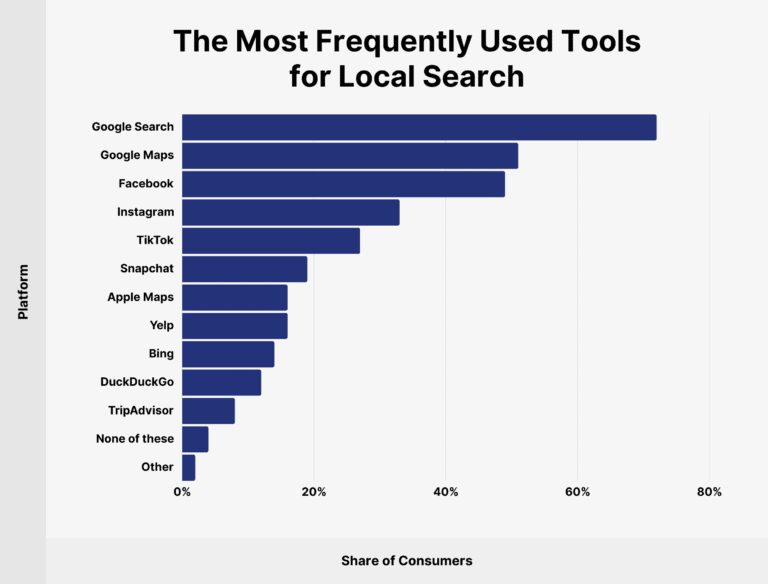
Source: Backlinko
8. Open Now Near Me, Searches Up By 400%.
Near me searches have been the mainstay for local SEO. However, it’s tough to set your business apart from millions of websites using these. Optimising around the “open now near me” search gives your site an edge, with keyword searches spiking by 400% in volume at a record pace.
9. 87% of consumers view service quality as the top consideration in online reviews.
When sifting through online reviews, Aussies often let the reviews do the talking. It’s not even new that some people intuitively filter out negative or poor reviews to avoid a product or service.
About 87% of consumers say service quality is the most important factor in reviews, while 78% say cost is equally important.
These figures provide insights into what Aussies prioritise when reading customer reviews. Businesses should strike a balance between offering best-in-class services and charging upfront prices to encourage positive online feedback.
10. Complete Google Business Profiles Attract 7x More Clicks.
As search engine algorithms constantly change, you must tick a long list of key factors to rank high. One factor Google looks at is how involved you are locally. Google even states that a complete, active business profile listing gets 7x more clicks than empty ones.
In a BrightLocal study comparing four countries, Australian brands with active Google Business Profiles (GBP) have the highest monthly actions (67 clicks, directions, requests, and calls). Since Google cross-checks your GBP updates with local events, getting involved helps your site’s ranking and ramp up clickthrough.
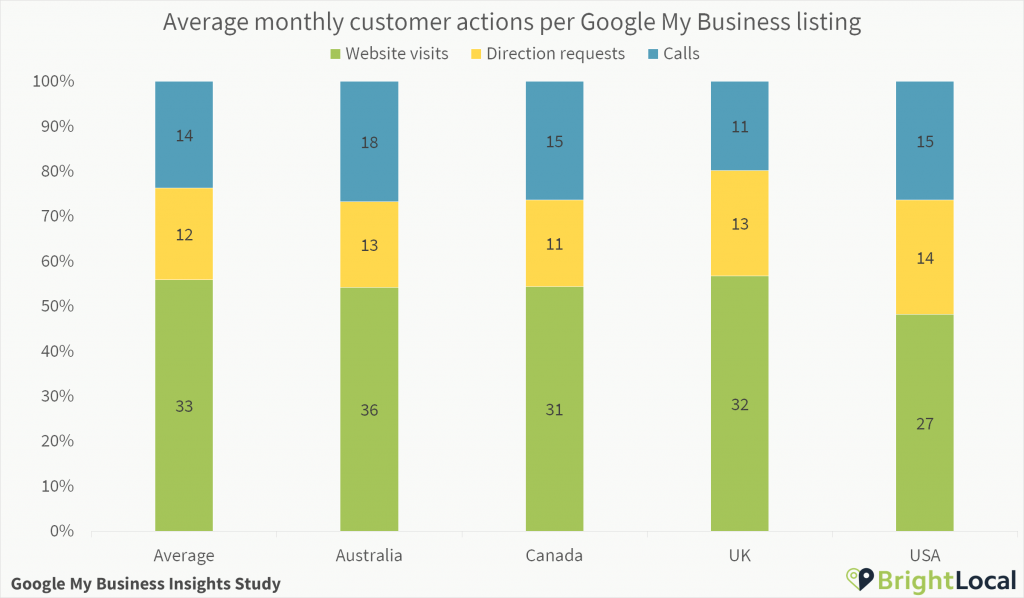
Source: Brightlocal
11. 88% of local searches result in a call or visit to the business within 24 hours.
About 88% of customers who do mobile local searches either call or visit a store within a day. This is why maintaining accurate business information, responsive contacts, or local mentions is important to engage with potential customers actively.
12. 72% of users performing local search queries visited a store within five miles.
While one-third of local searches have purchasing intent, almost three-fourths of users (72%) who do such queries have visited a store within five miles. This is the impact of a trusted online presence, not just for brick-and-mortar stores, turning locals into loyal, buying customers.
13. 47% of business websites appear in Google’s first ten organic results through local search queries
In a flood of local search queries, almost half of Google’s first ten organic results (47%) are business websites. As Aussies perceive these top organic results as trustworthy, it’s no surprise that they’re attracting streams of potential customers.
Trailing behind these brand websites are directories (31%), mentions (16%), and forums (7%). Besides a robust website, investing in these helps catapult your site closer to page-one dominance, organically at scale.
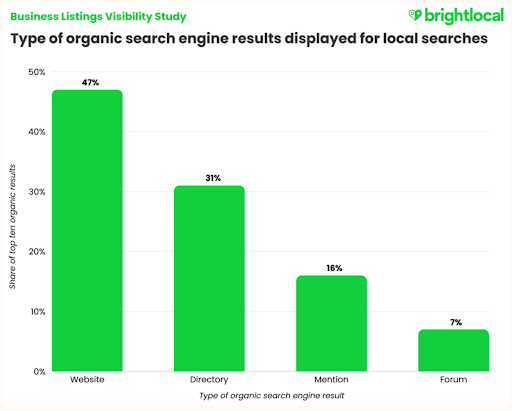
Source: BrightLocal
14. ChatGPT Search shows 58% of business websites on its local search sources.
ChatGPT is gaining traction for local search, though Google Search remains the top go-to source. Nearly three-fifths of business websites (58%) appear on ChatGPT local search, slightly higher than Google’s search engine results.
This strongly suggests that Chatgpt understands the intent when users phrase a brand, product, or service in their search queries. While business mentions are up by more than a quarter (27%), directories drop by 15% (compared to Google). On the other hand, forums often fall flat and are not visible at all.
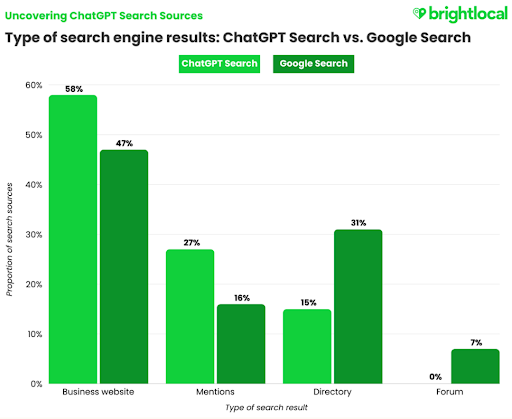
Source: BrightLocal
15. 71% of people do not consider businesses with review ratings below three stars.
Businesses with poor review ratings below three stars lack appeal to 7 out of 10 potential customers. These ratings, however, are not enough to fully convince Aussie buyers. Most users weigh not just these ratings, but also read and trust stories and genuine business reviews.
16. 88% of people prefer that businesses respond to positive and negative reviews.
While negative reviews can deter potential customers, some can be manipulative, spammy, or misleading. This is why 88% of consumers prefer a business that responds to both positive and negative reviews.
So, users aren’t left with one-sided impressions, especially in uncontrollable mishaps. Meanwhile, only 47% of surveyed individuals would still consider a business even without responding to reviews at all.
17. About 86% of Australians place low trust in local businesses using AI.
If you use AI in business to scale content at lightning speed, adding a personal touch is important to align well with local search queries. However, roughly 86% of Australian consumers still place little trust in local organisations that use AI to handle their personal data. This is a critical guardrail to limit AI in decision-making and high-risk settings to gain customers’ full trust.
18. Roughly 1 in 3 Aussie digital shoppers is open to using AI to find good prices for products or services.
With AI Overview redefining search experiences, your business can appear with a detailed summary. It even ends each search session short without clicking any links. That’s why about 30% of Aussies are open to using AI to find the best prices for products and services online.
Optimising your business for Google’s AI Overview is another tactic to scale your brand reach. While this promises more clicks, it requires more nuanced, hyperlocal content that fits perfectly with the user’s intent. By mastering these shifts, your brand can become the first name people trust.
19. 42% of Millennials performing a Google Maps search visit the physical shop for an in-store purchase.
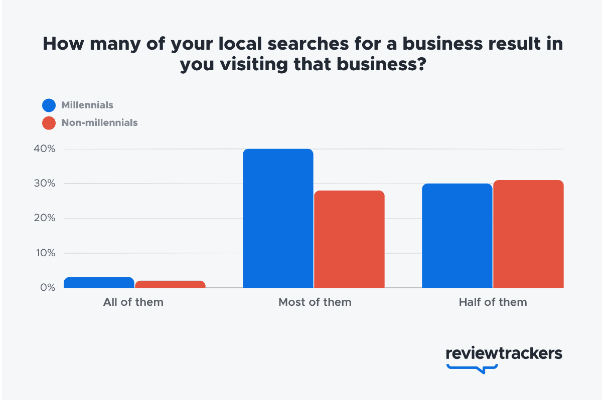
Source: Reviewtrackers
It comes as no surprise from the digital natives that 42% of Millennials who use local search to browse for a store will visit it most of the time. 30% of Millennials on the go are 50% more likely to visit a local shop after searching locally.
Talk about getting used to making plans on the fly and using their phones to get directions.
Moreover, 40% of shoppers go to Google when researching a product they plan to make physically/in-store or online.
20. 55% of Australian local businesses haven’t claimed their Google Business Profile listing
Small and medium businesses should all create a Google Business Profile listing, which uses Google Maps to display business details to customers. Statistics show that in 2023, 55% of Australian local businesses will still need to be listed on Google Business Profile.
If you’re one of the 55% of Australian brands yet to claim their Google Business Profile listing, you’re missing out on opportunities to engage with your audience.
In 2024, only 42% of local businesses have optimised for local search. 31% of those who did not improve their rank in local search results would like to, but only 20% have an actual plan and do it themselves.
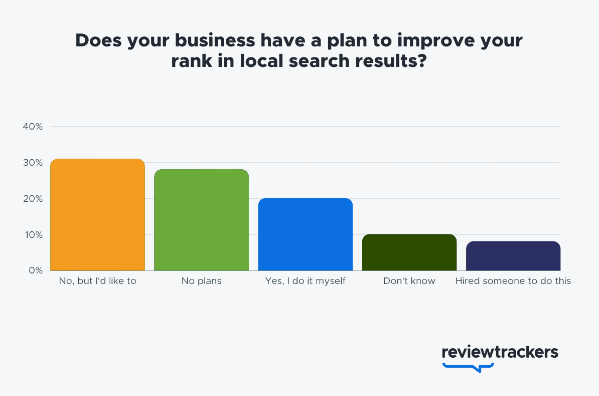
Source: Reviewtrackers
21. 45% of people use Google Maps when locating stores
Google Maps has always been the go-to site for people researching local stores and establishments. But with Google Map Pack driving more traffic and influencing physical purchases, the numbers have diversified in 2024.
The latest Brightlocal Local Business Discovery & Trust Report reveals that 66% of consumers trust Google when researching information about a local business. Google Maps comes in second, with 45% of consumers trusting the platform when searching for local businesses.
These figures further emphasise the importance of claiming your business’s Google Business Profile for physical establishments.
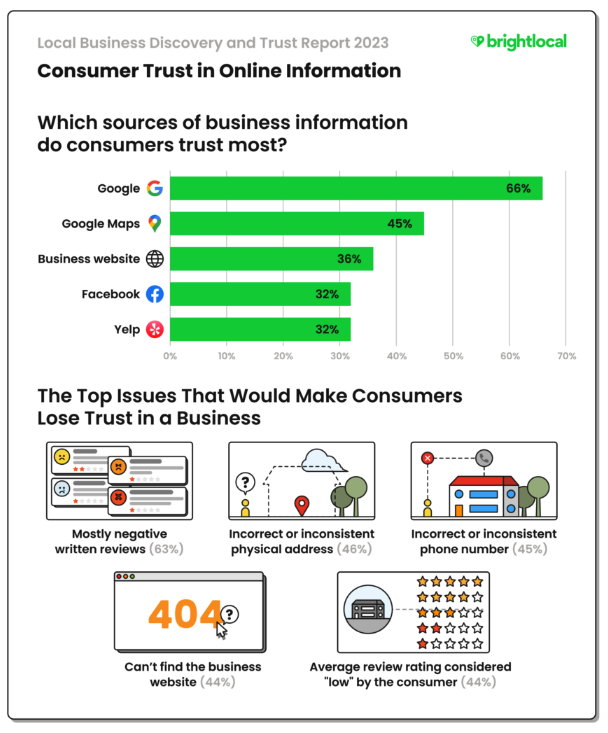
Source: Brightlocal
22. About 49.1% of people search for places and local vacation spots online
The latest Global Digital Reports show that 49.1% of Australians use the internet to research places, vacations, and travel destinations. While there’s no direct mention of “businesses” in this figure, it’s safe to say Aussies love researching hotels and shops in a local spot before travelling there in real life.
12% of respondents search for local businesses every day, while 54% check out local brands on Google once a month.
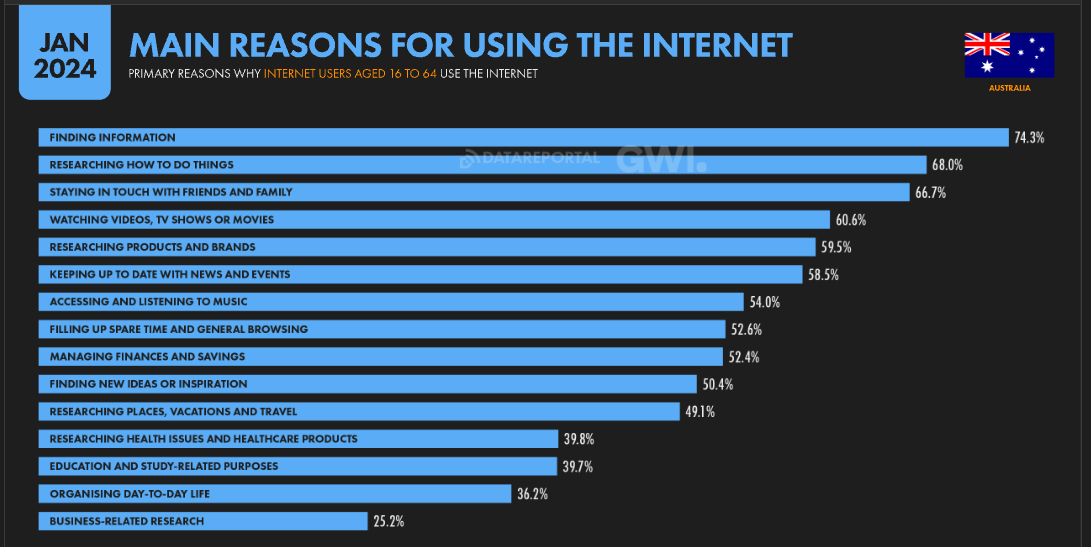
Source: Global Digital Report
23. 46% of Google searches in Australia have local intent
Almost half of Google searches are related to local establishments’ location and business hours. Out of 3.5 billion Google searches every day, more than 1.6 billion have local search intent.
24. 30% of Google searches performed on mobile are location-related
Along with the rising mobile search traffic in 2023, about 1 in 3 mobile searches is related to location.
Reviewtrackers also reported that 57% of local search queries are performed using a mobile device or tablet. Another study stated that 89% of local searches are performed with a web browser, and only 11% are done within Google Maps and other map-based apps.
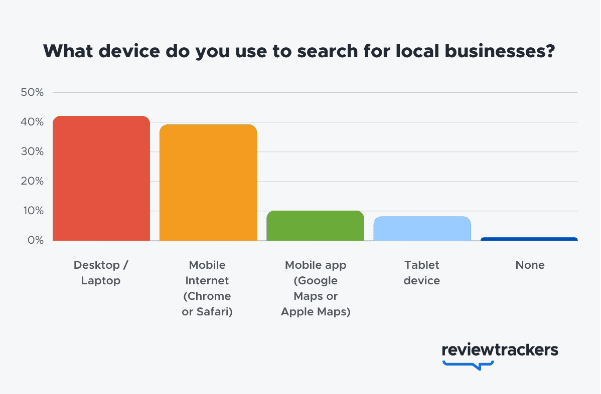
Source: Reviewtrackers
That said, include your store location and opening hours across your business profiles and website to ensure your audience can find you at home or on the go.
25. Roughly 28% of local searches lead to a purchase (both online and offline)
About one-third of local searches are likely to have purchase intent in mind. If a user finds out that your services or products are available nearby, they’ll likely purchase them after some searching.
26. 66% of consumers use business information sites to find a new local business
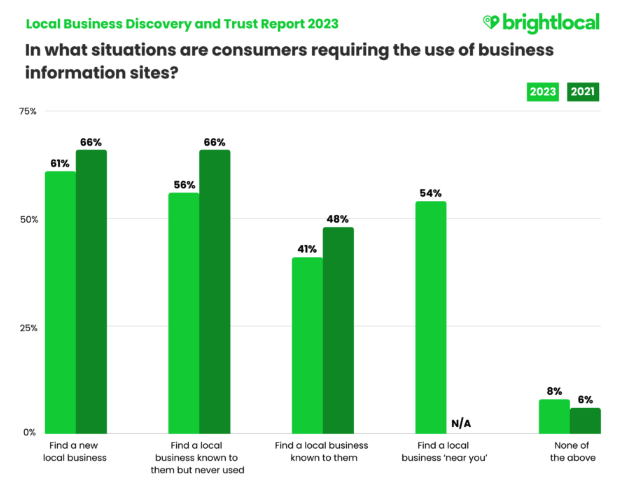
Source: Brightlocal
The latest Brightlocal study showed that the percentage of users using business websites to discover new local businesses dropped by 5% from 66% in 2021 to 61% in 2023.
The same trend is visible for users finding a local business known to them but never used as well as for known local businesses.
Moreover, 54% of consumers use business information websites to find a local business “near you”.
Capitalising on local search visibility and local SEO can maximise your traffic and tap into multiple revenue streams in an Australian landscape.
Local “Near Me” Search Statistics
27. Near me, searches grew by 136% in 2023
As soon as people learned about “near me” queries, it became indispensable in local search. For two years, the population of consumers using near me and buy now queries rose to a staggering 500%!
The latest Google Trends chart also shows that “near me” searches have an interest rating of 71%, with its peak (100%) during December 2023.
Furthermore, the keyword is most popular in Queensland, followed by Victoria, South Australia, New South Wales, Western Australia, the Northern Territory, and Tasmania.
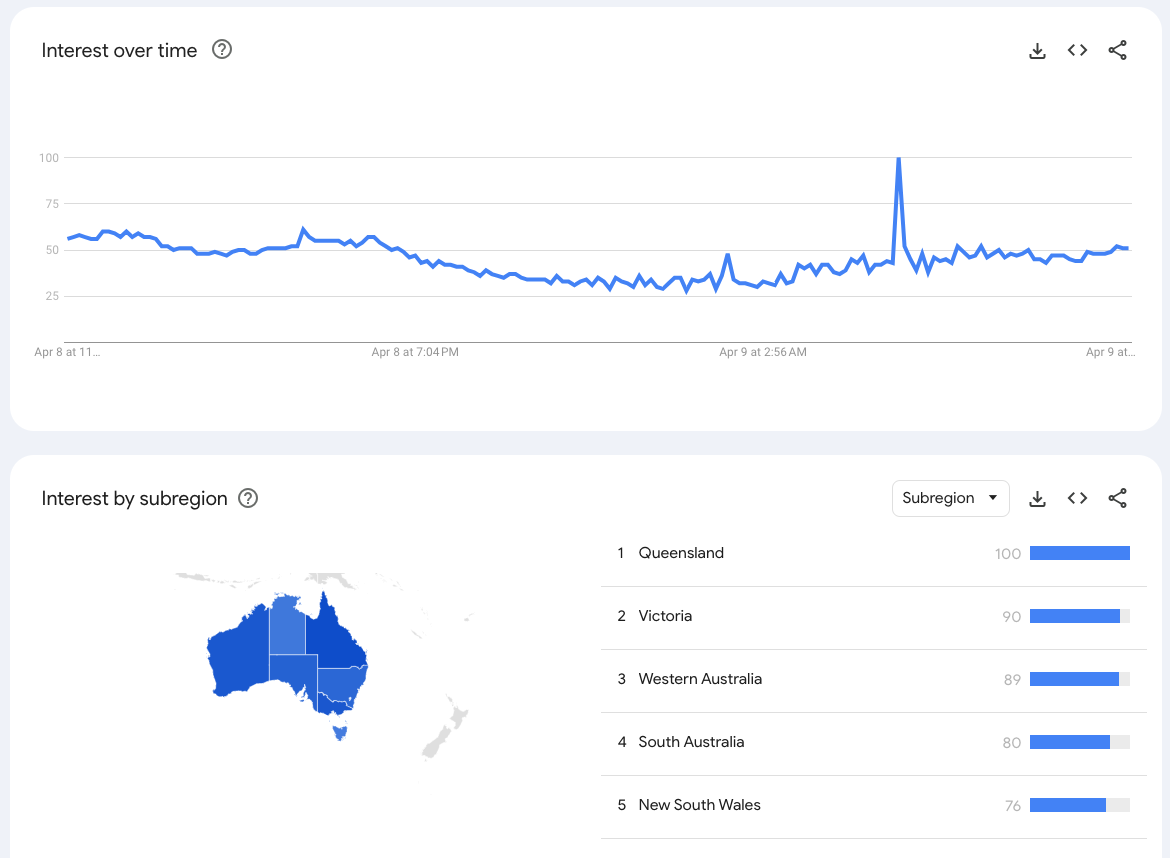
28. More than half of “Near Me” searches lead to a physical visit
Over 50% of Google search queries with “near me” keywords result in local in-store visits. In addition, brick-and-mortar businesses can leverage near-me searches by improving local search visibility across platforms and online channels.
29. Omnibuyers grow across Australia’s local business landscapes
More shoppers return to in-store buying, but not without local search. Shopping near me searches increased twofold YOY.
Google Maps searches for “shopping near me” have grown by over 100% year-on-year. More shoppers return to in-store buying. This gave rise to omnichannel shopping behaviour. 67% of shoppers will research products even if they intend to make a purchase in-store.
That’s because these habits are built around convenience and spontaneity. In fact, global searches containing “store open” keywords increased by 400% YOY.
30. Mobile search accounts for 84% of “Near Me” searches*
Local search has become enormously popular over the past few years. In 2023, “Near Me” searches covered more than 84% of all mobile search traffic.
Near me searches also grew by 500% in the past two years alone, making a reliable local SEO strategy still highly relevant if not crucial in 2024.
Moreover, mobile traffic is slightly higher in Australia’s summer months at 71% than the winter month average of 68%. Viewership during summer is also stronger than in other months, encouraging businesses to turn to YouTube for video content advertising and making it a key tool in their business strategies.
Local Online Shopping Statistics
31. 91% of Aussie shoppers use Google Search before buying in-store
In a post-pandemic market where people’s financial constraints and digital skills influence their buying habits, shoppers often find themselves in the messy middle.
It is a state between exploration and evaluation that begins with a trigger and ends with either a purchase or a feedback loop.
The latest Google Consumer Insights report states that 91% of Australians use Google Search before entering a store.
Aussies bounce across different shopping platforms and other channels, making it challenging to appear everywhere at once. Many businesses focus only on channels they think are closer to potential customers, leaving many opportunities unexploited.
Consider preparing for unexpected and seasonal rushes like Black Friday Sales or Christmas to maximise your results.
Here are some points to reach your audience as soon as they celebrate or consider buying something spontaneously.
- Be aware of what your consumers want. Google Trends and Insights will provide you with real-time data on what people are searching for, so you can quickly adjust your promotions.
- Work on becoming an omnichannel brand. Having visibility across a new digital channel can maximise your business’s ROI and efficiency by as much as 35%. Consider signing up for free Google channels such as Google Shopping so you can expand your reach without increasing your budget.
- Feed your campaigns with reliable data. Leveraging tools such as Google Merchant Centre can help you uncover market data. Additionally, Google Analytics provides an in-depth look at how people interact with your site. These tools help you improve your products and services around customer behaviour and feedback.
In a nutshell, it’s all about establishing a seamless online and offline customer journey.
32. 1 in 3 consumers choose their second favourite brand if it’s more visible than the primary choice
Customers who plan to purchase in-store still check online for store closing hours and product availability.
That said, consumers are 33% more likely to choose their second brand if they can’t find the product they want or confirm whether a store is open during weekends.
33. Almost two-thirds of Aussies will ignore a business without an online presence
About 63% of Australian consumers will not shop or visit a physical store if they can’t find any online information.
Google Reviews significantly influence a customer’s buying decision. That’s where local SEO becomes crucial. It’s useful in maintaining a legitimate business presence, as more people in 2023 don’t prefer invisible online shops.
34. Over 85% of people read online reviews before buying a product
You can inspect, touch, test, and check any product in-store before making a purchase. However, customers need to rely on high-quality media and technical specifications for online shopping.
That’s why over 85% of Australian consumers first read product reviews before making a purchase. Online businesses must then learn how to encourage previous buyers to leave a positive review, which helps reinforce the buying decisions of new visitors.
In addition, the latest Brightlocal Local Consumer Review Survey reported that 36% of local consumers check at least two (2) review sites before deciding to visit or buy from a local business.
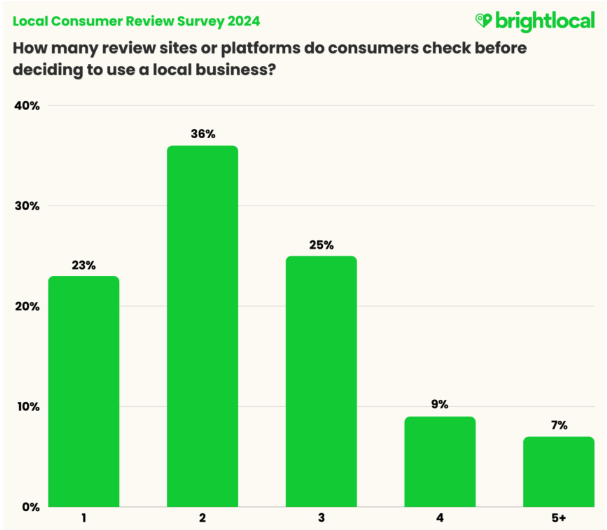
Source: Brightlocal
35. 61% of Australians consult Google for their shopping decisions
In 2024, Google reported that about 61% of Australian consumers use Google Search for in-store-related queries. Besides, as eCommerce picks up at an unprecedented pace, more people prefer the convenience and safety of online shopping.
Despite many restrictions easing out, online behaviour across Australia recorded a 79% growth YOY. Local search influenced $9 out of every $10 spent on shopping.
36. Almost 25% of local search traffic goes to the top-ranking site
Naturally, people trust first-page websites more than ones that rank on page two. That’s why websites ranking on Google’s first pages get as much as 24% of all organic traffic from local searches in 2023.
Local In-Store Shopping Statistics
37. 61% of Aussies feel that local shopping contributes to the community
Today’s Australian shoppers have three distinct characteristics:
- Open-minded
- Budget-conscious
- Locally-oriented
Research shows that consumers are keen on shopping to suit their unique needs. Aussies now look into where their products come from and whether they’re sustainable, considering aspects such as packaging, presentation, and delivery.
38. 33% of Aussies choose brands that are fast and early online
As discussed, the messy middle is a space where consumers explore and evaluate options. In this area, brands that appear early in consumer research receive the most attention.
Other factors influencing brand choice are convenience (43%), price (35%), and consistency (25%).
39. 35% of Australian customers are early shoppers
Business centres and shopping districts are becoming busy earlier than ever. You should expect product-related searches and Google Maps queries to flood months before a major shopping holiday.
A robust local SEO campaign should help you prepare and reach your customers at any time they make a buying decision. Businesses must prepare for unexpected traffic surges and late-night inquiries and maintain a seamless 24/7 service.
40. Consumers visit 1.5 billion physical locations from Google Search monthly
A recent Google study reported that users visit more than 1.5 billion destinations from local business searches every month. That means people aren’t just browsing for local businesses but also have the intent to visit physically.
41. More than 61% of users don’t prefer businesses that are invisible online
About 61% of online customers won’t purchase from businesses they can’t find online. That means you’re missing out on potential leads if you’re not visible to your online consumers.
Furthermore, local news has become the top alternative platform that 43% of consumers use to find local business reviews.
Word of mouth has become an increasingly powerful tool for advertising your business. It’s also an effective link-building tool that can help boost your website’s reputation as a credible local business.
42. 43% of customers search for a product when they are in the store
Now that customers have more options when purchasing online or offline, about 43% use Google to check quick reviews, store inventory, and discounts, even inside a physical store selling the product. That is especially true in the tech, fashion, and cosmetics industries in 2024.
43. About 30% of customers look for local stores every week
About 30% of customers browse local businesses, cafes, and tourist spots online every week, even without the intent to purchase.
Aside from claiming your Google Business Profile listing and other proven local SEO strategies, you can engage with potential customers through digital word-of-mouth advertisement and improve your reach online.
Conclusion
Local SEO has become vital to Australian businesses as Google Maps and local search behaviour increase in influencing purchasing decisions.
Talk with our experienced SEO Sydney specialists today, and we’ll discuss how you can leverage local SEO to grow your business.
Check out more related statistics through our posts below:
- Australian Mobile Phone Statistics
- Australian Internet Statistics
- Australian Google Search Trends Statistics
- Australian Buy Now & Pay Later Statistics
- Australian eCommerce Statistics
- Australian Voice Search Statistics
Frequently Asked Questions
1. How many Australians use Google to find local businesses?
Google is the juggernaut platform when discovering local Australian businesses, with 94.5% of Australians using the search engine.
Additionally, Google retained a high search utilisation despite the rise of AI, with an Australian search engine market share of 94% from 2021 to 2024, and currently holds a market share of 92.17%.
Platforms like Google Search and Google Maps are the most popular tools for finding local businesses. “Near Me” searches capitalise on this growing trend of location-based, geographic searches.
2. What percentage of clicks go to the first result on Google in Australia?
According to 2023 statistical data, the first position on Google in Australia has a typical CTR of 39.8%, while the second position has a CTR of 18.7%. This indicates that the first result gets twice as many clicks as the second.
Meanwhile, an analysis of over 13 million keywords in Australia in 2024 revealed that the average CTR for the first position is 29.5%, whilst the second position is 12.8%.
These shifts in figures could still vary depending on how saturated your industry verticals are. Notably, the top spot in search results could get between 3 and 4 out of 10 clicks.
3. How important is local SEO for Australian businesses?
Local searches tend to trigger a chain of store visits, onsite sales, and upticks in total purchases. This solidifies why local SEO is critical, with roughly 97-98% of Aussies using Google to look for local businesses nearby.
Local SEO is a mainstay for Australian businesses looking to scale their online presence or foot traffic. It helps business owners connect with active shoppers, ready to buy goods or step into brick-and-mortar stores.
4. How many businesses in Australia actively invest in SEO?
While it’s tough to pinpoint the exact figures at scale, it’s fairly common for Australian businesses to invest in SEO, especially in larger organisations, online firms, and digitally mature companies.
A 2023 study involving 700 Australian SMEs revealed that 36% of small businesses use SEO effectively or invest in it in some way. It’s noteworthy that 64% of SME owners were unaware of the substantial impact of SEO or how it works.
5. How much do Australian businesses spend on SEO annually?
By 2025, industry reports project Australian companies to spend over $1.5 billion on SEO services. This could rise sharply based on the business size, objectives, industry competition, and range of services utilised.
The following outlines annual SEO spending estimates by company type, based on widely cited monthly ranges as of early to mid-2025:
| Business Type | Average Annual SEO Investment |
| Small | $14,400 – $30,000 |
| Medium-Sized | $19,200 – $90,000 |
| Large | $30,000 – $120,000+ |
| Enterprise-Level | $90,000+ |
SEO investments in industry verticals like retail, trades, and healthcare also rely on the above criteria (size, competition, and extent of services). While specific statistics on SEO investment by industry are unavailable, existing data points indicate the following:
- Retail or E-commerce: Contributes to nearly 35% of overall SEO expenditures in Australia, likely eclipsing other industries investing in SEO.
- Trades: Monthly expenditures below $500 for this industry seem too low, yet expenses of $5,000 seem excessive.
- Healthcare: Projects a 7% growth in investment for SEO and content strategies.
6. What’s the average ROI of SEO for local businesses in Australia?
The mean SEO ROI for local Australian enterprises is high, with evidence suggesting up to 500% or more ROI. A surge in purchases from strategic, local SEO campaigns drives this increased return on investment.
The following table illustrates industry findings that emphasise the enormous worth of SEO compared to paid advertising.
| Industry Insights | Description |
| Higher Conversion Rates | Leads generated through SEO close at a much higher rate than outbound leads. SEO has a high close rate of 14.6% compared to 1.7% for techniques like direct mail or print advertising. |
| Cost-Effectiveness | SEO establishes long-term online equity. Once rankings are achieved, SEO fuels consistent traffic without incurring per-click costs, unlike paid advertising, and compounds return over time. |
| Sustainable Traffic and Asset Building | SEO establishes an enduring online presence, unlike paid campaigns that cease to yield results when your budget depletes entirely. |
| Increase Trust and Credibility | Organic results are more authentic and credible than paid listings because they seem less manipulative. Optimised websites pass certain algorithmic evaluations (like Google’s EEAT) before they rank high and successively appear in organic search results. |
Paid advertising is great if you’re looking for instant traffic or targeting short-term objectives. However, SEO far outweighs these costly metric gains, as it establishes your brand’s online presence sustainably.
7. What are the most searched industries or services in Australia?
SEMRush’s website traffic statistics reveal that the most popular online services (platforms) in Australia, as of February 2025, include:
| Rank | Website | Visits |
| 1 | google.com | 2,126,909,157 |
| 2 | youtube.com | 1,013,446,903 |
| 3 | facebook.com | 218,894,407 |
| 4 | reddit.com | 192,770,938 |
| 5 | wikipedia.org | 119,628,604 |
| 6 | instagram.com | 108,401,796 |
| 7 | bing.com | 107,780,568 |
| 8 | ozbargain.com.au | 74,056,922 |
| 9 | amazon.com.au | 62,404,739 |
| 10 | netflix.com | 60,368,682 |
Several reports also identify the fastest-growing sectors in Australia for 2025. These sectors include:
- Aged and Disability Care
- Cleaning and Gardening
- Post-Construction Services
- Societies, Associations, and Groups
- Tax Services
- Property/Real Estate
- Healthcare
- Computer Software/IT
- Travel and Tourism
- E-commerce
- Renewable Energy
- Cybersecurity
Understanding the search patterns and volumes in these is crucial to tailor your SEO campaign. By tracking consumer behaviours, you can also fine-tune your SEO strategies to align with your industry or the services you offer.
8. What percentage of Australians click on Google Ads vs organic results?
Global trends indicate that organic search captures a dominant share of clicks, falling between 85% and 90%. These approximate values align with the click rate on Google Search in Australia for the last year.
| Search Result Type | Estimated Percentage of Clicks |
| Organic Results (Overall) | 85-90% |
| Top 3 Organic Results | 50-60% |
| Google Ads (Overall) | 10-15% |
This highlights the critical importance of a well-crafted, sustained SEO strategy. It lays the groundwork for your sustainable growth, a trusted digital presence, and enduring brand awareness in Australia’s online space.
9. How long does it take to see SEO results for local Australian businesses?
Strategic SEO campaigns take time; it’s even a slow progression. Though there’s a long checklist in the pipeline, how saturated the online competition is in a local area can stall or fast-track tangible SEO returns.
Below is an estimated SEO timeline based on competition strength in Australia:
| Competition Level | Characteristics | Estimated Time for Noticeable Results (in months) |
| Low | Niche keywords, less saturated markets | 3 to 6 |
| Medium | Moderate keyword difficulty, established businesses | 6 to 12 |
| High | Competitive keywords, saturated urban markets | More than 12 |
Even high-effort SEO can take three months with little apparent effect. Companies can expect ranking improvements and upward traffic in three to six months. More noticeably, frequent gains are far more common for longer campaigns.
It’s fair and sound to have realistic, time-bound expectations. However, rushing SEO can harm your online property and presence. Concentrating on a bespoke, consistent strategy fuels sustainable online growth and optimal return on investment (ROI) in the long run.
Written by






